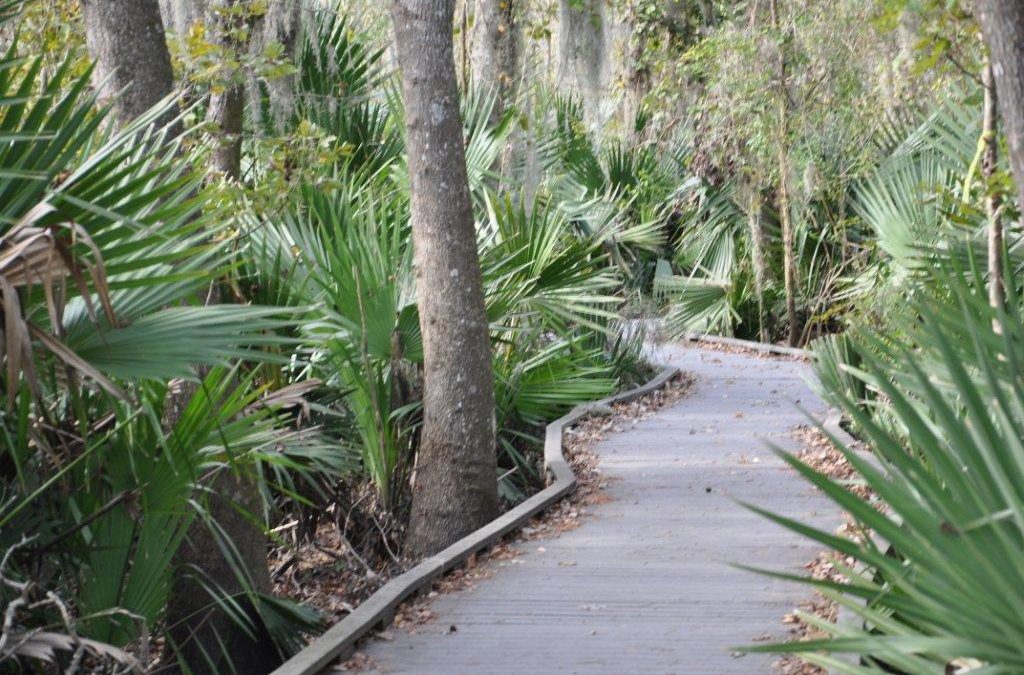
by admin | Nov 13, 2012 | Greater New Orleans
Although we’ve explored the trails at Jean Lafitte National Park’s Barataria Preserve dozens of times, every trip brings new discoveries. Sunday was the perfect day to visit, with mildly cool weather accented by rust-colored cypress trees and red maples (our version of fall colors).
.JPG) |
| Palmetto Trail |
With one sleeping babe and one rearing to go, we headed first for the Palmetto Trail, where quiet, long stretches of boardwalk suited everyone’s needs. The dark waters were peeking through lush, wild vegetation, pooling in small ponds under the shade of giant leaves. August napped to the rhythmic beat of the stroller wheels on wooden boards, while Charles filled his bug catcher with dried leaves and sticks, preparing a habitat for whatever unsuspecting bug he was sure to find.
For the most part, the trail was ours alone to embrace, the silence only broken a handful of times by mostly visitors with foreign accents. Aside from a few “pokey caterpillars” and elusive, croaking frogs, this initial hike was serene and uneventful–a grade A for us adults, but making our 4-year-old a little antsy at the unthinkable prospect of going home with an empty bug catcher.
.JPG) |
| Reflections in Bayou Coquille |
As we emerged from the giant palmettos and crossed the next parking lot, we once again entered the mysterious world of Louisiana’s swamps. Bayou Coquille was unusually clear of overgrowth and looked perfect for canoeing, and as the afternoon went on, the sky above the cypress trees became a fantastic blue.
We stopped several times to examine the spiders busily spinning their webs and looked forward to seeing the alligator we heard was lurking up ahead. As we stepped aside to allow some faster tourists to pass, Charles squealed with delight at spotting a giant, black lubber grasshopper waiting for him in the path. He impressed the passersby by fearlessly plucking the grasshopper from the ground and gently placing him in the prepared habitat.
.JPG) |
| Marsh Overlook |
It was enough to make this “the greatest day ever,” one that only got better when we finally spotted the 10-foot alligator lurking in the Lower Kenta Canal. He was well-hidden in this hyacinth-clogged canal, which looked so little like water that the kids thought they could walk right out on it.
Our leisurely stroll ended at the expansive marsh overlook. After a few relaxing moments of taking in the views, we strapped the kids in their strollers and starting sprinting back towards the Visitor’s Center. We had half an hour to cover the two miles back before the parking lot gates were closed at 5 p.m. Thankfully, the ranger was still waiting for us when we came huffing and puffing back to our car.
.JPG) |
| Parting views from the park |
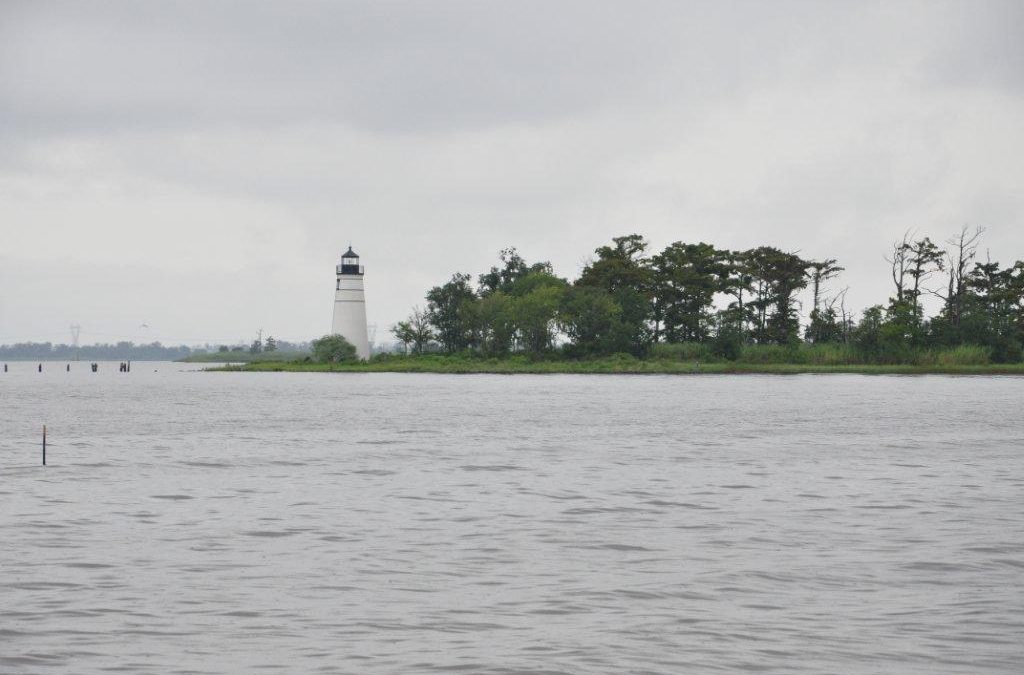
by admin | Aug 21, 2012 | Greater New Orleans
The tiny town of Madisonville perched its stilted houses and businesses along the banks of the Tchefuncte River, which flows south and widens as it enters Lake Pontchartrain. Countless days of rain had prompted us to visit this historic maritime community, whose past has been interwoven with water since the earliest days of settlement around 1800.
 |
| Lake Pontchartrain Basin Maritime Museum |
We escaped the day’s remaining drizzle inside the Lake Pontchartrain Basin Maritime Museum, where a 3 p.m. arrival gave us an hour before closing to tour the exhibits. The kids were a whirlwind, as usual, absorbing every creature, boat and picture at lightning speed. My four-year-old had found three alligators, a squirrel and a bobcat before the rest of us even made it past the visitor’s desk.
A dimly lit wooden walkway set the scene for a ride on an early steamboat, and upon entering the boat, we emerged into a theater showing the history of the Tchefuncte River. From model boats and lighthouses to a replica Civil War submarine and river pilot boat, every inch of the museum was chock full of interesting artifacts and details about the state’s long and unique reliance on water.
 |
| Tchefuncte Lighthouse |
Also under the Maritime Museum’s management is the elegant, black and white Tchefuncte Lighthouse. Although accessible only by boat, a bumpy drive to the end of the road placed us in perfect viewing distance. Originally built in 1837, the lighthouse was nearly a casualty of the Civil War but was rebuilt shortly after and still flashes its light today.
From the bottommost tip of the road, we traveled north to the opposite end of town, snapping photos of the tranquil river and historic courthouse (now a museum) and branch library. The riverfront restaurants were hopping with the exiting church crowd, and we picked up some quick seafood-to-go at Morton’s.
 |
| Otis House at Fairview-Riverside State Park |
Next up was Fairview-Riverside State Park, where we ate in a covered picnic pavilion while gazing at the lovely 19th century Otis House (open for tours Wednesday through Sunday). We walked the perimeter of the house toward the ponds and river behind it. The rain-soaked ground squelched beneath out feet as tiny frogs jumped ahead of our every step. Needless to say, the bug catcher was put to good use, and we had a fantastic time chasing the amphibians until a snake slithered across my path.
That was our cue to move on, and we drove past the campsites to the boardwalk swamp and river trails. Our arrival was greeted by those strangely large “Devil’s Horses” (palm-sized, black grasshoppers) sitting motionless in the grass, on the trees and along the boardwalk. A game ensued of my two-year-old spotting the critters, pointing one tiny finger at them and yelling his brother’s name until his older sibling made his rounds and fearlessly plopped them in the bug catcher.
As we left with our car full of critters, we stopped for a final glimpse of the setting sun casting a reddish glow on the cypress trees lining the water.
 |
| Sunset over the Tchefuncte River at Fairview-Riverside State Park |

by admin | Apr 17, 2012 | Greater New Orleans
French Quarter Fest, the largest free music festival in the South, is four, packed days of more than 800 local musicians playing on 22 stages throughout the Quarter’s historic streets and waterfront. Now in its 29th year, the event has ballooned into a massive festival rivaling that of the famous Jazz Fest occurring just a few weeks later.
 |
| An iconic horse and carriage tour |
It’s a tricky busy, though, trying to navigate an extremely well-attended festival with two very “energetic” little boys. Gone are the days when we could lounge in a lawn chair under a shade tree in Jackson Square, sipping daiquiris and savoring food from local restaurants while relaxing to a weekend of free music.
This year, we had to be strategic in our festival-going. We arrived early, strolling the nearly empty streets for more than an hour before the music started up and thousands of people seemed to materialize out of nowhere.The horse and carriage tours sauntering along the roads kept the kids’ attention, while we mapped out our route.
 |
| Palmetto Bug Stompers |
Our musical tour began with the classical stage at St. Mary’s Church at the Ursuline Convent, where the first show of the morning was Opera on Tap. We managed to make it through two songs before our oldest decided to try his own rendition of opera singing. Next up was the French Market Traditional Jazz Stage, where the crowd was dancing some fancy footwork to the Palmetto Bug Stompers. The beat was lively and so were the kids, bopping their heads around to the rhythm.
A slow song set our strollers in motion again, and as attention spans lasted through two, maybe three songs at a time, we hopped from stage to stage throughout the day. Luckily, there seemed to be music on nearly every corner, and we didn’t have to walk far to find the next group of toe-tapping musicians and the fans surrounding them.
 |
| Festival-goers dancing in the streets. |
Our path took us from Dutch Alley to Jackson Square, Preservation Hall to the Hermann-Grima House. We grabbed several dishes of food along the way and mostly ate on the run. Despite the lack of time to “savor” the flavors, we still appreciated the tasty delights served up by some of the city’s best restaurants, and our youngest took a particular liking to some grillades and cheese grits produced by K-Paul’s.
 |
| Local artists took advantage of the huge crowds. |
Throughout the day, our senses were captured over and over again, enveloped by the sights, sounds and tastes of an event that can only take place in New Orleans. For one long weekend, the city’s most talented musicians bring to life every steamy street corner, green space and dark, historic building. Meanwhile, the walls and fences are hung with colorful artwork for sale, and the rest of the space is covered in tempting food booths. It’s a chance to discover places you’ve never seen and sounds you’ve never heard, so if you didn’t make it this year, you should mark your calendar for April 2013.

by admin | Mar 14, 2012 | Greater New Orleans
Beyond Lake Pontchartrain and Covington, out past sprawling plant nurseries, lies the Global Wildlife Center in Folsom. We made the trek to the far reaches of the Northshore to see the more than 4,000 exotic animals that reside here at this 900-acre wildlife preserve.
 |
| Wagon tour of the Center |
As we drove alongside the property, our anticipation grew as we saw the animals frolicking in the fields before us. When our car turned in the main gate and crossed over the cattle guard, Charles thrust my iphone back into my hands to focus his full attention out the window. Dozens of wild animals walked slowly by, creatures we’d never seen before – not even in storybooks.
We approached the Visitor’s Center, thinking we’d buy tickets for the 1 p.m. tour and eat our PB&J sandwiches by the koi pond while we waited. It turned out the noon tour leaves at a quarter after, though, so we dragged the kids out of the gift shop and boarded the last in a string of covered wagons. Thinking we were on a train, Charles bounced about shouting “All Aboard!” while August clung to me in fear of all the new people around him.
As the “train” lurched forward, though, and we entered the animals’ realm, they both were overcome with pure and utter joy. Armed with our bucket of feed, we were shoveling cups of food into the animals’ mouths, while August was literally squealing with delight. If I hadn’t held him back, I’m almost positive the child would have jumped right in the middle of those four-legged grazers.
 |
| Bactrian Camel |
The numbers were astonishing, and the varieties of colors and types purely amazing. From the African kudus with their spiraled antlers and the two-humped bactrian camels to the ostrich-like rheas and the frisky pere david deer, we fed, pet and giggled at them all. While the giraffes were standoffish, the zebras were overjoyed with us and begged for our attention. The gentle llamas ate feed right out of my hand, while other animals ran away with the cups they were supposed to be eating out of.
A strong wind blew throughout the thrilling ride, and by the last ten minutes of the hour and a half tour, the boys were (for once in their lives) exhausted. That in itself is a rare feat to accomplish. We topped the trip off by feeding the giant koi and catfish living in the picnic area’s pond while scarfing down our sandwiches.
 |
| Bogue Chitto River |
It was a successful day, and we drove away with full intentions to head back home in triumph. But Charles gave his best puppy-dog look, and with his newly purchased elephant in hand, pleaded for us to continue the adventure. Paul and I are both suckers for that, and after a quick glance at the map, decided to swing past the state’s newest state park – Bogue Chitto. We drove the park’s loop, taking in the scenic views of the gorge and the Bogue Chitto River while letting the car’s movements lull August through an afternoon nap.
As we turned the last curve to exit the park, the toddler awakened and we used the opportunity to hike the gorge trail that had been beckoning to us since we first saw it. A path of leaves and pine needles led the way through the woods to stairs leading deep within the gorge. At the bottom, a boardwalk snaked around through a much wetter landscape, and lizards fled our every step. With lightning speed, Charles actually caught one and vowed to never let it go. Fortunately, the animal was resourceful and squirmed his way free. As the tears came rushing down, we decided the outing was over, and headed home to recoup and plan for the next adventure.
 |
| Stairway into the state park’s gorge |
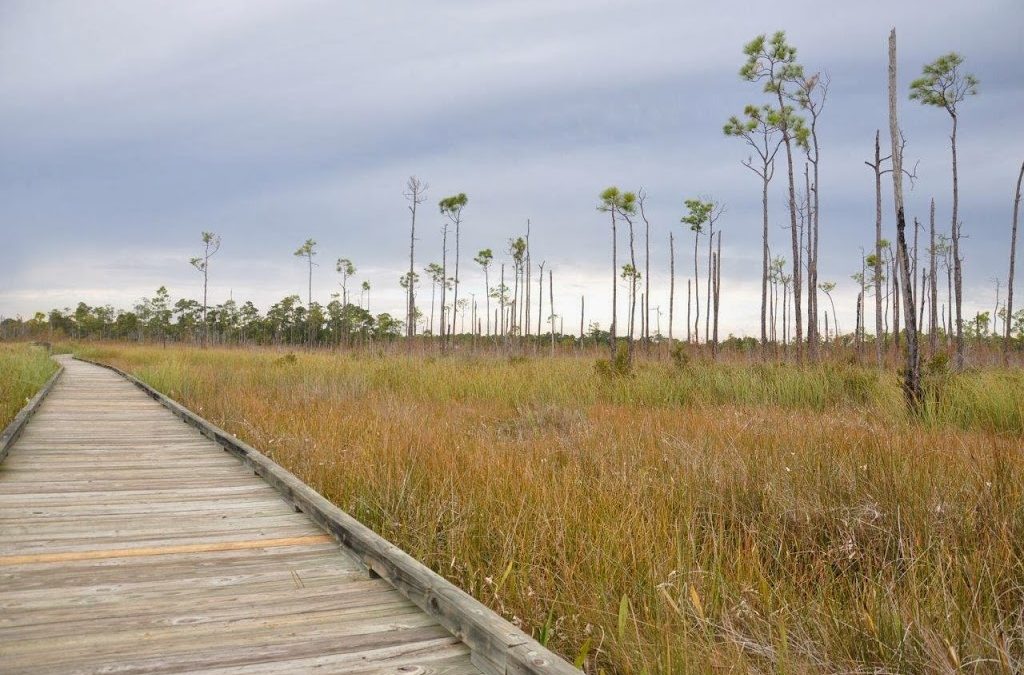
by admin | Feb 13, 2012 | Featured Posts, Greater New Orleans
Bundled in puffy jackets and hoods, we fought the weekend’s blustery weather and – in between Mardi Gras parades – carved out some time to discover another of Southeast Louisiana’s (SELA) eight National Wildlife Refuges. Encompassing nearly 19,000 acres of Lake Pontchartrain’s north shore, Big Branch Marsh NWR is another one of those remote gems, completely hidden within plain site of 1.2 million people.
Because of its close proximity to Big Branch Marsh, we began our journey at the Visitor Center for all eight of the SELA refuges. Just north of where Highways 434 and 190 intersect in Lacombe, this impressive complex was far beyond our expectations. A former Redemptorist seminary, the vast property retains the feel of a religious retreat with contemplative trails winding through sasanquas and camellias past a grotto, Bayou Lacombe and a cemetery for Redemptorist priests.
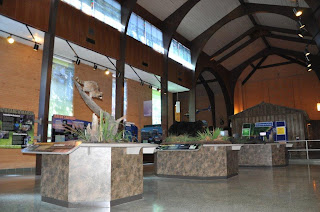 |
| SELA Refuges Visitor’s Center |
Stepping inside the Visitor’s Center, we instantly realized this cross-shaped building with vaulted ceilings was the former chapel. The U.S. Fish and Wildlife Service had done an amazing job turning the space into a natural science museum, complete with displays highlighting the eight refuges, preserved animals, a video and an interactive cabin. The kids gawked at the black bear and alligator before scaling the ramp to the intriguing shack. Inside, a dark room hid various Louisiana wildlife. I handed Charles an available flashlight and watched with delight as he discovered owls, snakes, turtles, deer and a bobcat. Every time his light landed on one of the lifelike eyes, it triggered the hoots and growls of the featured animal.
 |
| One of the many camellias along the Camellia Trail |
Outside, we followed the grotto and camellia trails past hundreds of blooming camellias, losing count as to the number of varieties of pinks, reds, whites, striped and polk-a-dot flowers. As Paul paused to read the names of the priests buried in the cemetery, the kids and I traveled the final camellia lane where we discovered the find of the century – at least to a three-year-old. A two-foot snakeskin completely intact appeared to be slithering across the path. It now holds a place on his dresser next to his cicada shells and caterpillar cocoon that hopefully will soon become a monarch butterfly.
 |
| The pine forest of Big Branch Marsh NWR |
The sun was well on its way in its descent into the horizon, so we hurried back along Highway 190 to the Big Branch Marsh boardwalk and nature trail. A half-mile, self-guided tour immersed us into pine flatwoods that opened up to a lilly pad covered freshwater marsh. The wind was brutal in the open area, at one point launching an empty stroller into the water, but the serene views of saw grass and birds were well worth our endeavors. However, at the end of the boardwalk, we followed the limestone trail back to our car rather than continue along the 4-mile roundtrip Boy Scout Road Tour.
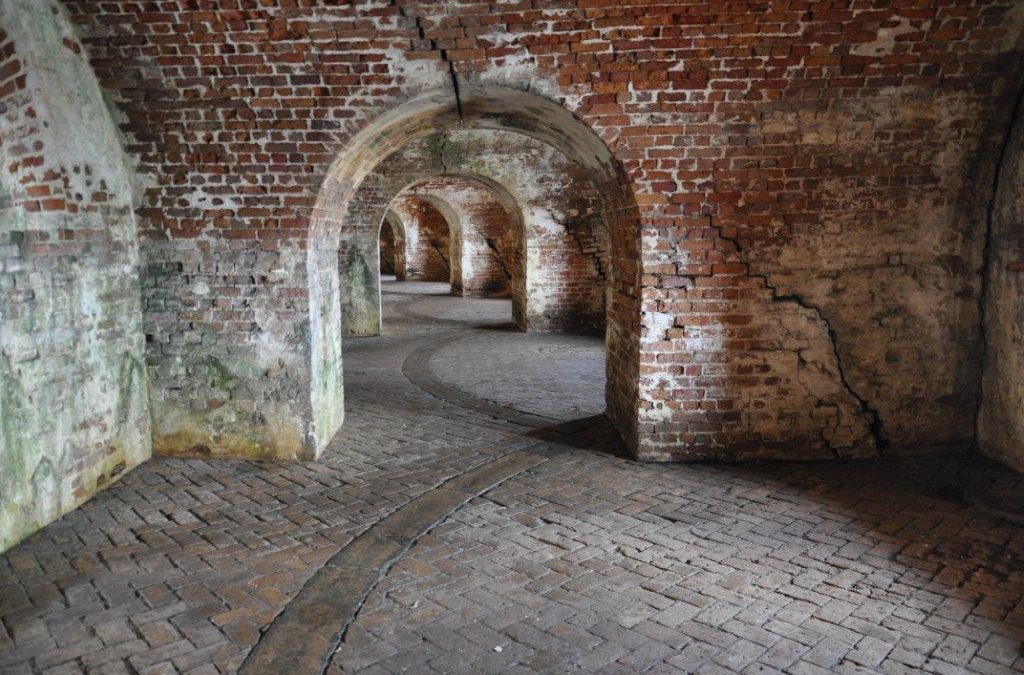
by admin | Jan 25, 2012 | Greater New Orleans
Beyond a line of Vietnamese stores and restaurants, Chef Menteur Highway journeys to the far edges of New Orleans, deep into the nation’s largest urban National Wildlife Refuge. Just a short distance from our house,
Bayou Sauvage NWR is a flashback to what much of this area used to look like – or perhaps more of what the natural landscape has become.
 |
| Fort Pike on The Rigolets Pass |
|
 |
| Bayou Sauvage National Wildlife Refuge |
As we took our time unfolding strollers and loading in kids and snacks, a rush of cars filed into the previously empty parking lot. Almost on cue, doors flew open and members of the Slidell Hiking Club emerged. While they milled around the display of posters describing the refuge, we scooted down the boardwalk out of sight.
There was no water standing under the wooden walkway, and 3-year-old Charles seemed thoroughly confused as to why we couldn’t walk on the ground. We distracted him from his interrogation with a challenge to race. The end of the 2/3 mile trail came sooner than expected, and we unbuckled August and let him stretch his legs while we took in the expansive landscape in front of us.
The entire route had been enveloped with short vegetation and an occasional live oak. Here, at the end, though, short cypress knees and stubby tree trunks were all that remained from the saltwater damaged and logged forest. The landscape was strangely barren at first glance, but when we looked deeper, there were signs of life everywhere. Far in the distance, an island of live oak trees towered over the flat land, marking the spot where Tchefuncte Indians once built ancient shell middens.
 |
| Abandoned Fort Macomb |
As the Slidell hikers approached, we finished off the loop and continued out Chef Menteur toward Fort Pike State Historic Site, pausing first to snap a few pictures of the abandoned 19th century Fort Macomb along the shores of Chef Menteur Pass. Overgrown and crumbling into the waters surrounding it, Fort Macomb appeared to be the forgotten stepchild of the two forts designed to protect Lake Pontchartrain. On the other hand, Fort Pike, which once guarded The Rigolets (French for “Little Ditch”) pass to the lake, was staffed and open for viewing – and for shooting movies apparently. When we arrived this past weekend, the fort was still recovering from serving as the background for “G.I. Joe 2.”
 |
| Great Horned Owl |
While August and I paid the modest $4 entry fee, Paul and Charles began investigating the feathers and other bird parts littering the ground around a large oak tree. One quick glance up, and they were astonished to see a two-foot-tall great horned owl glaring down at them. He’s a permanent fixture in the tree, and as we learned from the park guide, his mate spends her days under the nearby bridge. They meet up at night to hunt and eat.
Across the moat, we entered the cool, brick arches of Fort Pike. Completed in 1828, the fort served in various capacities in the Seminole Wars, the Mexican War and the Civil War. Although aged from time and the elements, the fort was largely intact, complete with the interior citadel stronghold. Rooms are marked to denote their original purpose, such as a bakery, general store and officers’ quarters, and strategically placed cannons look out over the waters beyond. I pushed the stroller up the rooftop ramp, and we carefully made our way around the top of the fortress, watching the pelicans gracefully fly past. I easily imagined myself transported back in time to live here on this serene site, and then I shuddered to realize the soldiers and their bustling activity that would have been happening all around me.
 |
| Inside Fort Pike |







